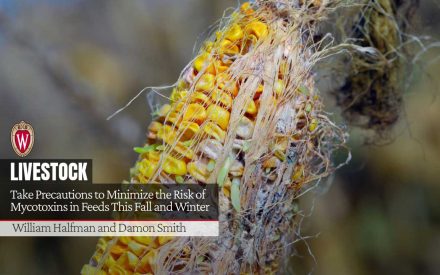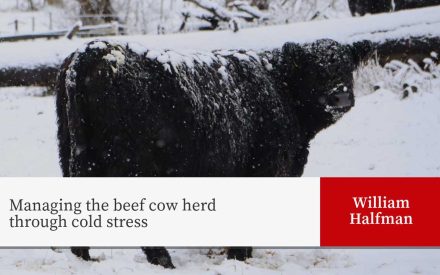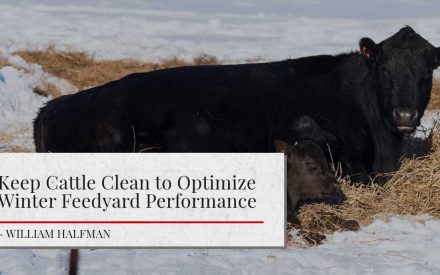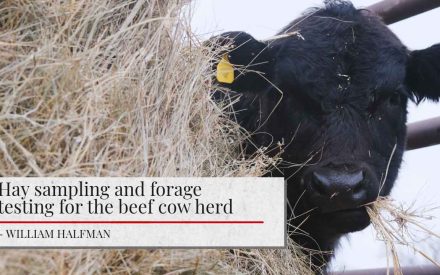Winter feed costs typcially represent the largest portion of cow/calf expenses. A hay analysis is important to determine if hay will meet a cow herd’s nutrient requirements during winter. This factsheet will cover interpreting a hay analysis and to calculate winter feed needs.
How do I sample my hay?
Tips to sample hay:
- Use a hay probe to obtain samples from bales. Most UW Extension offices have
a hay probe, which can be borrowed to obtain a sample. - Get a sample from the center of the bale (not the outside).
- Sample 10-12 bales, which allow for a representative hay sample from a ‘lot’.
- Mix the cores into a plastic bag, label bag, and send bag to the lab.
- Sample different lots of forage (different species, harvest date, field, weathering)
Forage Analysis- What analysis do I need?
Feed analysis labs will usually offer two types of analysis:
• Near Infrared Reflectance Spectroscopy (NIR) is a rapid, reliable, low-cost, computerized method to analyze feeds for their nutrient content.
• Wet chemistry analysis is more expensive and takes longer, but is also more accurate. For beef cow nutrition,
this is not necessary for forages. Grains and co-products are recommended to use this analysis because NIR is not accurate enough to predict the nutrient composition of these types of feeds.
Forage Analysis- What in the analysis do I need to use?
Most important results in hay analysis report for beef cattle:
- Dry Matter (DM): Amount of moisture in the feed. This is important because nutrient requirements are based on DM.
- Crude Protein (CP): For beef cows, the CP value is usually adequate to determine if the feed will meet requirements. If forage or feed has heat damage, the adjusted CP value substracts the amount of heat damaged protein from gross CP, thus providing a better estimate available to the animal.
- Energy (TDN or NEm):
• TDN (total digestible nutrients): This is the sum of digetible fiber, protein, lipid, and carbohydrate components of the feed. This may overestimate the amount of energy available to the animal.
• NEm (Net energy of maintanence): This is the amount of calories per pound of feed that will go toward to maintence of the animal. This is a more accurate estimate of what energy is available to the animal.
Figure 1: Example hay analysis

How do I calculate if hay will meet cow’s needs for winter?
Step 1. To determine expected DM intake (DMI) if hay is provided free choice use Table 1. Using the hay analysis on pg 1 ( TDN = 46% and CP = 10%), this hay sample would fall into medium quality hay due to TDN content. If cow herd average body weight is 1200 lbs, then expected maxiumum DMI of hay would be 24 lb/day (1200 lb cow x 0.02, % of body weight).

Step 2. To determine if hay will meet CP requirements of cow herd use Table 2. The cow herd’s needs for 1 month prior to calving (when dry cow requirements are the greatest) are 2.19 lbs of CP intake per day. Based on step 1, the cow will consume 2.4 lbs of CP per day (24 lbs DMI x 0.10 % CP of hay). Therefore, this hay will slightly exceed required CP intake during late gestation for the cow herd.
Step 3. To determine if hay will meet energy requirements of cows use Table 2. Based on Step 1, the daily intake of TDN will be 11.04 lbs per day (24 lbs DMI x 0.46 hay % TDN) or 8.4 Mcal/d of NEm (24 DMI x 0.35 hay Mcal NEm). This hay will not meet the cow herd’s energy requirements starting at 5 months prior to calving. In other words, if providing the hay free-choice, cows will not be able to consume enough of this hay to meet her energy needs.
If requirements are NOT met in Steps 2 or 3, this will result in cows losing body condition score (BCS). Here are someoptions to maintain BCS:
- Feed a supplement (grain or co-product) to meet protein and/or energy needs. To compare feeds on a cost per pound of CP or Mcal, here is spreadsheet to compare: https://fyi.extension.wisc.edu/wbic/files/2018/11/UW-feed-cost-tool-10-30-18.xlsx
- Feed the forage until this does not meet needs of the cow and then feed a higher quailty forage.
- Feed a combination of low and high quality forage to meet needs of the cow.
If requirements are in EXCESS in Steps 2 or 3, this will result in overfeeding and cows gaining BCS. If cows are too fat, this can cause problems in calving and breeding. To reduce feed costs:
- Limit intake to only meet requirements of cow.
- Feed a lower quality forage with a high quality forage
- Save high quality forage for replacement heifers; backgrounding calves; later in gestation/early lactation; or cold weather and then feed lower quality forage otherwise

Step 4: To calculate how much supplement is needed if hay does not meet cow’s enery or protein needs. Using the previous example, at 5 months prior to calving 1.0 Mcal NEm per day will be required and at 1 month prior to calving 5 Mcal NEm per day will be needed. Using dried distllers grains (DDGS; 0.96 NEm Mcal/lb) as a potential
supplement to hay, cows will need to be supplemented at 5 months with 1 lb DM of DDGS per day (1 Mcal/d x 0.96 DDGS Mcal/lb), whereas at 1 month with 5 lbs DM of DDGS per day (5 Mcal/d x 0.96 DDGS Mcal/lb). In this example, protein does not need to be supplemented.
Note: If calving during the winter months and a portion of the winter feed needs are for lactating cows, then nutrient requirements of lactating cow are greater than lategestation and should be adjusted for milk production. To find post-calving nutrient requirements here: http://www.nap.edu/catalog.php?record_id=9791
How do I calculate amount of feed needed to increase BCS or cold weather?
Increase Body Condition Score During Winter
If cows at weaning have an average BCS of 4 and need to reach a BCS 5 at calving, in 120 days cows will be required to gain 1.5 lbs per day. To calculate amount of additional feed to gain BCS, net energy of gain (NEg = amount of calories of feed alloted to gain above NEm) of the feed is needed. For the previous example, 3.20 Mcal NEg per day in addition to requirements for NEm in Table 1.
In the previous example, the hay analysis from pg 1 would not be able to meet these needs. If supplementing DDGS (NEg= 0.66 Mcal/lb), 4.8 lbs of DM per day will be needed to supplement to change BCS (3.20 Mcal NEg needed/0.66Mcal NEg of DDGS). Or a higher quality forage may be used to meet these needs and substituted for this medium quality forage.

Cold Weather Adjustments
For every 2°F the temperature drops, an increase of 1.1 lbs of TDN is needed to meet the cow’s daily requirements below a cow’s critical temperature (Table 4). For example, if temperatures fall below 10°F for high temperatures for 1 week, cows will require supplementation of 4.5 lbs of TDN (8/2 * 1.1) per day. With poor to medium quality forage, cows may not be able to consume enough of the forage to meet her energy needs at this time, therefore see previous suggestions to meet energy needs.

How do I estimate hay needs for the winter?
How do I estimate hay needs for the winter?
To estimate hay needs:
Step 1: Convert dry matter intake needed per day to as-fed intake. If the intake is 24 lbs/day and dry matter of forage is 70%, then the as-fed intake will be 34 lbs/d (24 lbs DMI/0.70 % DM).
Step 2: Estimate how much will be needed for the winter based on number of cows and days feeding forage. If a 20 head cow herd is expected to winter feed for 150 days, this would amount to 51 tons of hay needed (34 lbs as-fed intake x 20 cows x 150 days/2000 lbs/ton).
Step 3: Estimate hay losses from storage and feeding. This can vary from 4-50% depending on method. If we assume 20% is lost due to storage and feeding then total amount of hay needed would be 62 tons (51 tons hay needed * 1.20).

Resources
Buskirk, D.D., R.P. Lemenager, and L.A. Horstman. 1992. Estimation of net energy requirements(NEm and NEg) of lactating beef cows. J. Anim. Sci. 70:3867-3876.
Corah, L.R., R.P. Lemenager, P.L. Houghton, and D.A. Blasi. 1991. Feeding your cows by body condition. C-842. Kansas State University Agricultural Experiment Station and Cooperative Extension Service.
Encinias, A. M. and G. P. Lardy. 2000. Body Condition Scoring I: Managing Your Cow Herd Through Body Condition Scoring. AS- 1026. North Dakota State University Cooperative Extension. http://www.ag.ndsu.edu/pubs/ansci/beef/as1026w.htm.
Encinias, A. M. 2000. Body Condition Scoring II: Using the Net Energy (NE) System to Improve Body Condition Score, AS-1198. North Dakota State University Cooperative Extension. http://www.ag.ndsu.edu/pubs/ansci/beef/as1198w.htm.
Marston, T. T., D. A. Blasi, F. K. Brazle, and G. L. Kuhle. 1998. Beef cow nutrition guide. C-735 Kansas State University Agricultural Experiment Station and Cooperative Extension Service.
Patterson, J. Interpreting a forage analysis summary. http://animalrangeextension.montana.edu/articles/beef/nutrition/interpret. htm
Saxe, C. Big Bale Storage Losses; how different options stack up. http://www.uwex.edu/ces/crops/uwforage/BigBaleStorage-FOF. pdf

 Take Precautions to Minimize the Risk of Mycotoxins in Feeds This Fall and Winter
Take Precautions to Minimize the Risk of Mycotoxins in Feeds This Fall and Winter Managing the beef cow herd through cold stress
Managing the beef cow herd through cold stress Keep Cattle Clean to Optimize Winter Feedyard Performance
Keep Cattle Clean to Optimize Winter Feedyard Performance Hay sampling and forage testing for the beef cow herd
Hay sampling and forage testing for the beef cow herd


